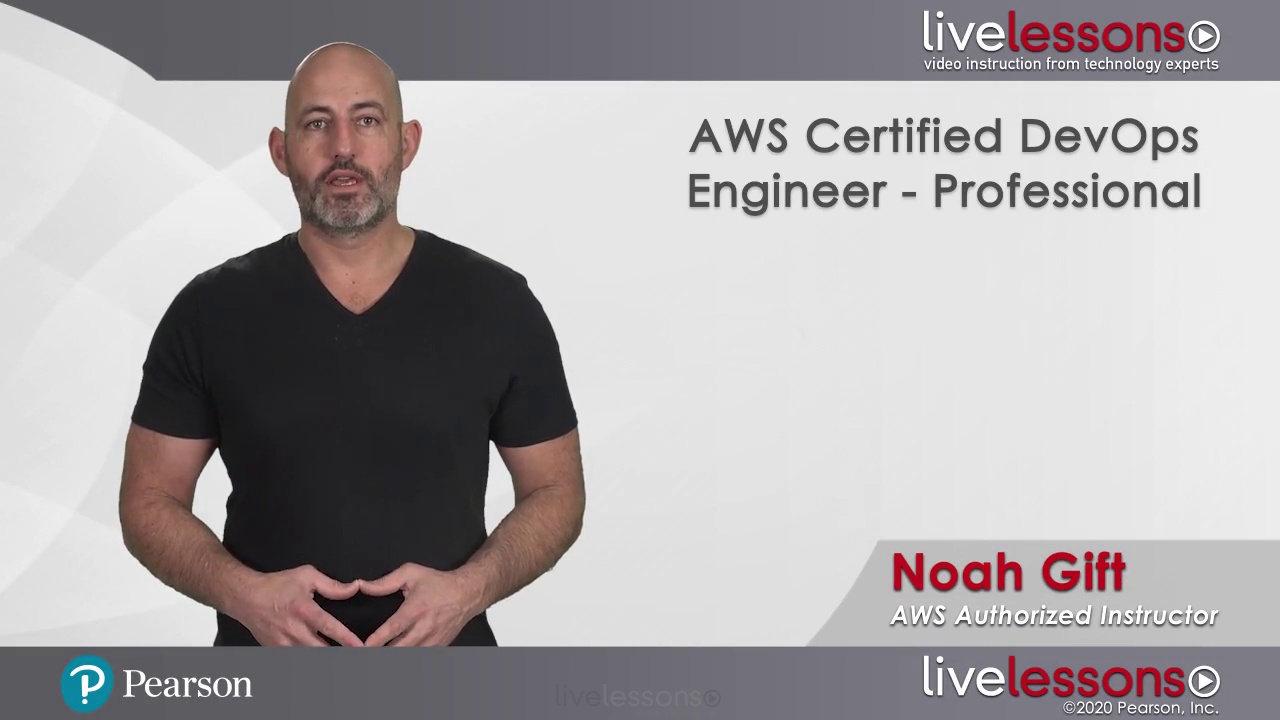AWS Certified DevOps Engineer - Professional Complete Video Course (VideoTraining)
- By Noah Gift
- Published Mar 19, 2020 by Addison-Wesley Professional.
Online Video
- Sorry, this book is no longer in print.
- About this video
Video accessible from your Account page after purchase.
Register your product to gain access to bonus material or receive a coupon.
Description
- Copyright 2020
- Edition: 1st
- Online Video
- ISBN-10: 0-13-661298-9
- ISBN-13: 978-0-13-661298-8
Nearly 4 Hours of Video Instruction
Cloud adoption is greater than ever. However, there is a shortage of skilled practitioners who not only can use the cloud, but can optimize it. DevOps is a catchall word for a series of behaviors that can dramatically increase the operational efficiency of the cloud. DevOps best practices include continuous integration, continuous delivery, Microservices, teamwork and collaboration, and monitoring.
This course covers the essentials of DevOps Professional on AWS and prepares a candidate to sit for the DevOps Professional Certification exam.
Description
The AWS Certified Developer Complete Video Course focuses on the AWS Certified DevOps Engineer - Professional Exam. The leader in cloud computing by market share, Amazon and their DevOps Professional certification allows you to demonstrate that you have mastered the essential skills of operationalizing a cloud.
Seven main categories are covered: AWS Certified DevOps Engineer Overview; SDLC Automation; Configuration Management and Infrastructure as Code; Monitoring and Logging; Policies and Standards Automation; Incident and Event Response; and High Availability, Fault Tolerance, and Disaster Recovery. The material focuses on teaching the concepts necessary to pass the exam and be competent as a DevOps practitioner on AWS.
Skill Level
- Intermediate
What You Will Learn
- Perform DevOps tasks on AWS
- Use SDLC automation to solve DevOps problems on AWS
- Perform Monitoring tasks on the AWS platform
- Use IaC (Infrastructure as Code) to deploy new environments
- Optimize your score on the AWS DevOps Certification exam for the best outcome
Who Should Take This Course
- DevOps Engineer who wants to understand how to operationalize Cloud workloads
- Software Engineer who wants to ensure they have a mastery of DevOps terminology and practices on AWS
- Machine Learning or Data Engineer who wants to solidify their knowledge on AWS DevOps practices
- Product Manager who needs to understand the AWS DevOps lifecycle
- Those new to DevOps and want to challenge themselves to obtain these skills in the cloud
Course Requirements
Prerequisites:
- Experience developing code in at least one high-level programming language
- Experience building highly automated infrastructures
- Experience administering operating systems
- Understanding of modern development and operations processes and methodologies
About Pearson Video Training
Pearson publishes expert-led video tutorials covering a wide selection of technology topics designed to teach you the skills you need to succeed. These professional and personal technology videos feature world-leading author instructors published by your trusted technology brands: Addison-Wesley, Cisco Press, Pearson IT Certification, Prentice Hall, Sams, and Que Topics include: IT Certification, Network Security, Cisco Technology, Programming, Web Development, Mobile Development, and more. Learn more about Pearson Video training at http://www.informit.com/video.
Video Lessons are available for download for offline viewing within the streaming format. Look for the green arrow in each lesson.
Sample Content
Table of Contents
Introduction
Lesson 1: AWS Certified DevOps Engineer - Professional Certification
Learning objectives
1.1 Get an overview of the certification
1.2 Use exam study resources
1.3 Review the exam guide
1.4 Learn the exam strategy
1.5 Learn the best practices of DevOps on AWS
1.6 Learn the techniques to accelerate hands-on practice
1.7 Understand important DevOps-related services
Lesson 2: SDLC Automation
Learning objectives
2.1 Apply concepts required to automate a CI/CD pipeline
2.2 Determine source control strategies and implement them
2.3 Apply concepts required to automate and integrate testing
2.4 Apply concepts required to build and manage artifacts securely
2.5 Determine deployment/delivery strategies and implement them using AWS Services
Lesson 3: Configuration Management and Infrastructure as Code
Learning objectives
3.1 Determine deployment services based on deployment needs
3.2 Determine application and infrastructure deployment models based on business needs
3.3 Apply security concepts in the automation of resource provisioning
3.4 Implement lifecycle hooks on a deployment
3.5 Apply concepts required to manage systems using AWS configuration management tools and services
Lesson 4: Monitoring and Logging
Learning objectives
4.1 Set up the aggregation, storage, and analysis of logs and metrics
4.2 Apply concepts required to automate monitoring and event management of an environment
4.3 Apply concepts required to audit, log, and monitor operating systems, infrastructures, and applications
4.4 Implement tagging and other metadata strategies
Lesson 5: Policies and Standards Automation
Learning objectives
5.1 Apply concepts required to enforce standards for logging, metrics, monitoring, testing, and security
5.2 Determine how to optimize cost through automation
5.3 Apply concepts required to implement governance strategies
Lesson 6: Incident and Event Response
Learning objectives
6.1 Troubleshoot issues and determine how to restore operations
6.2 Determine how to automate event management and alerting
6.3 Apply concepts required to implement automated healing
6.4 Apply concepts required to set up event-driven automated actions
Lesson 7: High Availability, Fault Tolerance, and Disaster Recovery
Learning objectives
7.1 Determine appropriate use of multi-AZ versus multi-region architectures
7.2 Determine how to implement high availability, scalability, and fault tolerance
7.3 Determine the right services based on business needs
7.4 Determine how to design and automate disaster recovery strategies
7.5 Evaluate a deployment for points of failure
Summary
